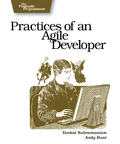Toolshed Technologies
Andy Hunt
Musician, Author, Programmer
Tell, Don't Ask
—Andy Hunt
07/01/1998
Published in Toolshed Newsletters
This time out we’ll talk about some practical issues concerning object oriented software development, mostly focused on issues of class responsibility:
- Telling vs. Asking
- Demeter’s Law
- Command/Query Separation
In quick summary: Keep your orders and your facts separate, tell as little about yourself as possible, and don’t talk to others any more than is necessary.
Tell vs. Ask
Alec Sharp, in the recent book Smalltalk by Example [SHARP], points up a very valuable lesson in few words:
“Procedural code gets information then makes decisions. Object-oriented code tells objects to do things.”
That is, you should endeavor to tell objects what you want them to do; do not ask them questions about their state, make a decision, and then tell them what to do.
The problem is that, as the caller, you should not be making decisions based on the state of the called object that result in you then changing the state of the object. The logic you are implementing is probably the called object’s responsibility, not yours. For you to make decisions outside the object violates its encapsulation.
Sure, you may say, that’s obvious. I’d never write code like that.
Still, it’s very easy to get lulled into examining some referenced object and then calling different methods based on the results. But that may not be the best way to go about doing it. Tell the object what you want. Let it figure out how to do it. Think declaratively instead of procedurally!
It is easier to stay out of this trap if you start by designing classes
based on their responsibilities, you can then progress naturally to
specifying commands that the class may execute, as opposed
to queries that inform you as to the state of the object.
(See my guide to Object Oriented development for more).
Just the Data
The main purpose of this exercise is to ensure a correct division of responsibility that places the right functionality in the right class without causing excess coupling to other classes.
The biggest danger here is that by asking for data from an object,
you are only getting data. You’re not getting an object – not
in the large sense. Even if the thing you received from a
query is an object structurally (e.g., a String) it is
no longer an object semantically. It no longer has any association
with its owner object. Just because you got a string whose contents
was “RED”, you can’t ask the string what that means. Is it the owners
last name? The color of the car? The current condition of the tachometer?
An object knows these things, data does not.
The fundamental principle of Object Oriented programming is the unification of methods and data. Splitting this up inappropriately gets you right back to procedural programming.
Invariants aren’t enough
Every class has invariants—things that must always be true. Some languages (like Eiffel) provide direct support for specifying and checking invariants. Most languages do not, but that only means that the invariants are not stated. They still exist. For instance, an iterator has the invariant that (using Java as an example):
hasMoreElements() == true
// implies that:
nextElement()
// will return a value
In other words, if hasMoreElements() is true, then attempting
to get the next element must succeed, or something is seriously
broken. If you are running multi-threaded code without the proper
synchronization (locking), it may well be that the above invariant doesn’t
hold: some other thread grabbed the last element before you did.
The invariant doesn’t hold; so something is wrong—you have a bug.
According to Design by Contract, as long as your methods (queries and commands ) can be freely intermixed, and there is no way to violate the class invariant by doing so, then you are ok. But while you are maintaining the class invariant, you may have also dramatically increased the coupling between the caller and the callee depending on how much state you have exposed.
For instance, suppose you have a container object C.
You could expose iterators for the held objects in this container,
as many of the JDK core routines do,
or you could provide a method that would run some function over
all members in the collections for you. In Java you might declare
this as something like:
public interface Applyable {
public void each(Object anObject);
}
...
public class SomeClass {
void apply(Applyable);
}
// Called as:
SomeClass foo;
...
foo.apply(new Applyable() {
public void each(Object anObject) {
//do what you want to anObject
}
});
(Forgive the neologic barbarism of “Apply-able”, we’ve found it handy to name interfaces as “-able”, but English isn’t as cooperative as one would like).
This is easier to code in languages with function pointers, and even easier in Perl or Smalltalk where such concepts are built in, but you should get the idea: “run this function over all contained items, I don’t care how.”
You can achieve the same results both ways, either via an apply
sort of method or via iterators. The choice really comes down to
how much coupling you are willing to have:
To minimize coupling, expose the minimum amount of state necessary.
As shown here, apply exposes less state than exposing
an iterator does.
Law of Demeter
So we’ve decided to expose as little state as we need to in order to accomplish our goals. Great! Now within our class can we just starting sending commands and queries to any other object in the system will-nilly? Well, you could, but that would be a bad idea, according to the Law of Demeter. The Law of Demeter tries to restrict class interaction in order to minimize coupling among classes. (For a good discussion on this topic, see [APPLETON]).
What that means is that the more objects you talk to, the more you run the risk of getting broken when one of them changes. So not only do you want to say as little as possible, you don’t want to talk to more objects than you need to either. In fact, according to the Law of Demeter for Methods:
Any method of an object should only call methods belonging to:
- itself.
- any parameters that were passed in to the method.
- any objects it created.
- any composite objects.
Specifically missing from this list is methods belonging to objects that were returned from some other call. For example (we’ll use Java syntax here):
SortedList thingy = someObject.getEmployeeList();
thingy.addElementWithKey(foo.getKey(), foo);
is what we are trying to prevent. (We also have an example of
Asking instead of Telling in foo.getKey()).
Direct access of a child like this
extends coupling from the caller farther than it needs to be.
The caller is depending on these facts:
- someObject holds employees in a
SortedList. - SortedList’s add method is
addElementWithKey() - foo’s method to query its key is
getKey()
Instead, this should be:
someObject.addToThingy(foo);
Now the caller is only depending on the fact that it can add a
foo to thingy, which sounds high level
enough to have been a responsibility, not too dependent on implementation.
The disadvantage, of course, is that you end up writing many small wrapper methods that do very little but delegate container traversal and such. The cost tradeoff is between that inefficiency and higher class coupling.
The higher the degree of coupling between classes, the higher the odds that any change you make will break something somewhere else. This tends to create fragile, brittle code.
Depending on your application, the development and maintenance costs of high class coupling may easily swamp run-time inefficiencies in most cases.
Command/Query Separation
Now back to to the ask vs. tell thing. To ask is a query, to tell is a command. I subscribe to the notion of maintaining these as separate methods. Why bother?
-
It helps to maintain the “Tell, Don’t Ask” principle if you think in terms of commands that perform a very specific, well defined action.
-
It helps you to think about class invariants if you class is primarily command based. (If you are just tossing data out, you probably aren’t thinking much in the way of invariants).
-
If you can assume that evaluation of a query is free of any side effects, then you can:
- use queries from within a debugger without affecting the process under test.
- create built-in, automatic regression tests.
- evaluate class invariants, pre- and post-conditions.
The last, of course, is why Eiffel requires only side-effect free methods to be called from within an Assertion. But even in C++ or Java, if you want to manually check the state of an object at some point in the code, you can do so with confidence if you know the queries you are calling will not cause anything else to change.
References
- [SHARP] Sharp, A. “Smalltalk By Example”McGraw-Hill, 1997.
- [APPLETON] Appleton, B. Law of Demeter OTUG Mailing List posting
Thanks to Dave “Doubting” Thomas for his perspectives on invariance.
Copyright © 1998,1999 Toolshed Technologies, Inc. All Rights Reserved
Keep up to date with my low-volume newsletter and don't miss another article or fresh idea:





Latest News
-
Greenfield, Brownfield... Blackfield?
July 24, 2024 -
New article: The Limits of Process
January 25, 2022 -
New article: Habits vs. Practices
January 5, 2022 - List All News...



